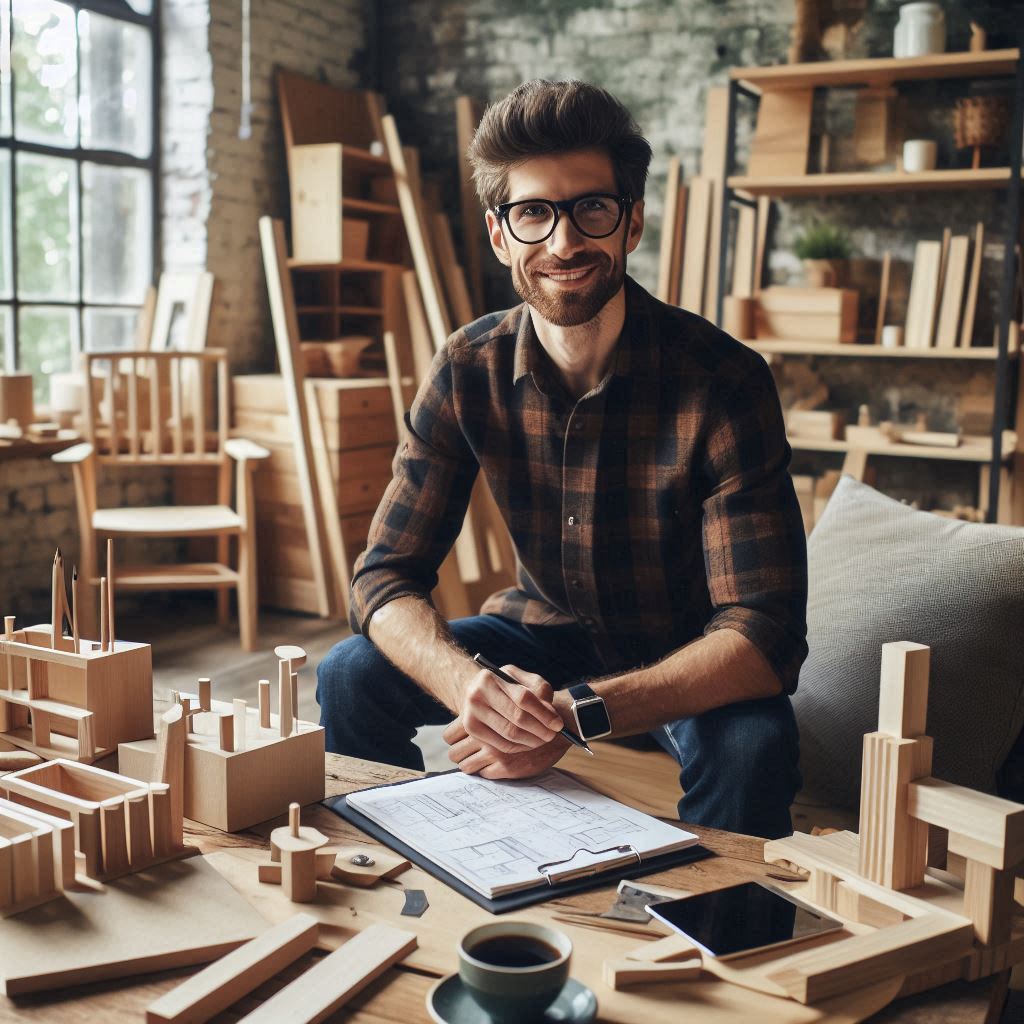Introduction
Interior design trends constantly evolve, reflecting changes in culture, technology, and lifestyle.
These trends shape how spaces look and feel.
They influence color palettes, materials, and overall aesthetics.
Furniture plays a vital role in these trends, acting as both functional and decorative elements in our homes.
The relationship between interior design trends and furniture is significant.
As trends emerge, furniture designs adapt to meet new styles and preferences.
Designers create pieces that enhance contemporary trends while ensuring comfort and practicality.
This dynamic interplay allows spaces to feel fresh and inviting.
In recent years, several top interior design trends have influenced furniture styles.
First, sustainable design has gained momentum, prompting furniture makers to use eco-friendly materials.
Second, multifunctional furniture has become popular, catering to smaller living spaces and busy lifestyles.
Third, bold colors and patterns are making a comeback, adding vibrancy to interiors.
Lastly, minimalism continues to influence furniture design, emphasizing clean lines and simplicity.
These trends not only define aesthetics but also enhance our living experiences.
Embracing these influences can transform spaces into reflections of personal style and modern living.
As we explore these trends, we’ll discover how they shape the future of furniture design.
Sustainability and Eco-Friendly Designs
The interior design industry is witnessing a significant shift towards sustainability and eco-friendly designs.
This trend reflects the rise of eco-conscious consumers who prioritize environmental responsibility in their purchasing decisions.
As awareness about climate change and environmental issues grows, consumers increasingly seek furniture that aligns with their values.
They want stylish options that do not harm the planet.
The Rise of Eco-Conscious Consumers
Manufacturers respond to this demand by creating furniture from sustainable materials.
Bamboo, reclaimed wood, and organic fabrics are gaining traction in the market.
Bamboo stands out due to its rapid growth and minimal environmental impact.
It is a versatile material used for various furniture types, from chairs to tables.
Reclaimed wood, sourced from old structures, adds character to new furniture pieces.
This wood reduces waste while offering a rustic aesthetic that many consumers adore.
Moreover, organic fabrics, free from harmful chemicals, provide a healthy alternative for upholstery.
These materials promote sustainability while ensuring comfort and durability.
They appeal to consumers who want stylish designs without compromising their health or the environment.
Designers increasingly incorporate these eco-friendly materials into their work, creating beautiful pieces that also make a positive impact.
Furniture Made from Sustainable Materials
The popularity of recycled and upcycled furniture pieces further emphasizes the move towards sustainability.
Consumers appreciate the unique character of upcycled furniture, as each piece tells its own story.
Designers are creatively reimagining discarded items into functional furniture, turning waste into beautiful decor.
This not only reduces landfill waste but also adds a sense of individuality to interior spaces.
Additionally, many brands now offer furniture collections that showcase recycled materials.
For instance, some manufacturers produce chairs and tables using recycled plastics and metals.
These innovative designs demonstrate that sustainable furniture can be both functional and stylish.
Consumers can enjoy modern aesthetics while supporting eco-friendly practices.
The Popularity of Recycled and Upcycled Furniture Pieces
Eco-friendly designs extend beyond materials; they also incorporate sustainable manufacturing practices.
Brands are increasingly adopting energy-efficient processes and reducing waste throughout production.
This commitment to sustainability resonates with consumers who are conscious of their environmental footprint.
By choosing eco-friendly furniture, they actively contribute to a healthier planet.
Furthermore, the rise of certifications like Forest Stewardship Council (FSC) ensures that consumers can identify responsibly sourced products.
These certifications provide transparency, enabling eco-conscious consumers to make informed choices.
As awareness of these certifications grows, consumers are more likely to seek out sustainable options.
In review, sustainability and eco-friendly designs significantly influence current furniture trends.
The rise of eco-conscious consumers drives manufacturers to create stylish, sustainable options.
Furniture made from sustainable materials, along with the popularity of recycled and upcycled pieces, highlights this transformative shift.
As the demand for eco-friendly designs continues to rise, the interior design industry will evolve, prioritizing environmental responsibility and innovation.
This shift ultimately leads to a more sustainable future for both consumers and the planet.
Read: Networking Events for Costume Designers
Minimalism in Interior Design
The Concept of Minimalism in Interior Design
Minimalism is a popular design philosophy that emphasizes simplicity and functionality.
In interior design, minimalism encourages clean lines and uncluttered spaces.
It fosters a sense of calm and serenity, making homes feel more spacious.
This design style resonates with many homeowners who seek tranquility in their living environments.
Showcase Furniture Pieces with Clean Lines and Simple Aesthetics
Furniture plays a crucial role in minimalistic interiors.
Designers often select pieces with simple shapes and neutral colors.
Sofas and chairs may feature straight lines and smooth surfaces, enhancing the overall aesthetic.
Coffee tables made of glass or light wood reflect a minimalist ethos, providing function without overwhelming a room.
Sleek shelving units can replace bulky cabinets, creating an airy atmosphere.
The Appeal of Minimalism in Modern Homes
One of the appealing aspects of minimalism is its versatility.
It fits seamlessly into various architectural styles, from modern to traditional.
Homeowners can easily incorporate minimalist furniture into their spaces.
Another important feature of minimalism is its focus on quality over quantity.
Instead of overcrowding a room with furnishings, minimalism advocates for fewer, well-crafted pieces.
A single, striking artwork can serve as a focal point, elevating the overall design.
Minimalism also emphasizes sustainable living.
By choosing fewer items, homeowners can make more deliberate purchases.
Many furniture brands now focus on eco-friendly materials and production methods.
This shift aligns with the minimalist principle of valuing quality and longevity.
Moreover, minimalism promotes a lifestyle that prioritizes mindfulness.
By surrounding ourselves with fewer distractions, we can appreciate our spaces more fully.
This shift can lead to reduced stress and increased satisfaction in daily life.
In modern homes, the appeal of minimalism continues to grow.
As people seek refuge from chaotic lifestyles, minimalistic designs offer a sanctuary.
Homeowners appreciate the clean, organized look that minimalism provides.
It encourages a harmonious living space where every piece serves a purpose.
The trend of minimalism in interior design influences how we view furniture.
It teaches us to appreciate simplicity and the beauty of unadorned spaces.
By selecting furniture with clean lines and understated elegance, we can transform our homes.
Minimalism invites us to create environments that reflect our values and enhance our well-being.
In this way, minimalism remains a timeless trend in interior design.
Read: Building a Portfolio for Costume Design
Biophilic Design
Biophilic Design and Its Impact on Interiors
Firstly, biophilic design connects people with nature, creating a harmonious environment.
This design philosophy promotes integrating natural elements into interior spaces.
By incorporating aspects of the natural world, designers enhance the well-being of occupants.
Biophilic design seeks to satisfy our innate desire to connect with nature, benefiting both our physical and mental health.
Explore Furniture Inspired by Nature
In recent years, furniture inspired by nature has gained significant popularity.
Designers draw from natural forms, textures, and materials to create unique pieces.
For instance, tables resembling tree trunks or chairs mimicking flowing water evoke a sense of the outdoors.
Organic shapes and earthy colors dominate this trend, inviting a serene atmosphere into homes and offices.
Natural materials play a pivotal role in biophilic design.
Wood, stone, and bamboo are popular choices that resonate with nature.
These materials bring warmth and texture into interiors, making spaces feel more inviting.
Furniture crafted from reclaimed wood not only tells a story but also contributes to sustainability.
By using responsibly sourced materials, designers create a positive impact on the environment.
Benefits of Incorporating Natural Elements into Furniture Designs
Incorporating natural elements into furniture designs offers numerous benefits.
First, it fosters a sense of calm and tranquility.
Natural textures and colors promote relaxation and reduce stress levels.
Studies show that exposure to nature enhances mood and productivity.
This is particularly valuable in workspaces, where stress can negatively impact performance.
Additionally, biophilic furniture can improve air quality.
Plants integrated into furniture, such as living walls or planters, help purify the air.
They absorb toxins and release oxygen, creating a healthier environment.
This is crucial in urban settings, where air quality is often compromised.
Biophilic design also encourages mindfulness and connection to the environment.
When surrounded by natural elements, individuals become more aware of their surroundings.
This awareness fosters a deeper appreciation for nature and its importance.
It inspires people to engage in sustainable practices and protect the environment.
Furthermore, furniture that embodies biophilic design enhances aesthetic appeal.
The organic forms and natural materials create visually stunning pieces.
They act as conversation starters and elevate the overall design of a space.
As a result, interiors become more inviting and engaging for occupants and visitors alike.
In essence, biophilic design significantly impacts contemporary furniture trends.
It draws inspiration from nature, enhancing aesthetics and promoting well-being.
By incorporating natural elements into furniture designs, we create spaces that resonate with our innate connection to the environment.
Embracing this trend enriches our lives and nurtures our relationship with nature.
As we move forward, biophilic design will continue to shape the future of interior design, reminding us of the beauty and importance of our natural world.
Read: Essential Skills for Aspiring Costume Designers

Vintage and Retro Styles
The resurgence of vintage and retro furniture has captivated interior design enthusiasts.
Homeowners and designers increasingly seek pieces that evoke nostalgia.
This trend reflects a desire for authenticity and personality in modern interiors.
Vintage and retro styles offer a way to infuse character and warmth into living spaces.
Key Characteristics of Vintage-Inspired Pieces
Key characteristics of vintage-inspired pieces stand out in today’s design landscape.
These items often feature unique materials, bold colors, and distinctive shapes.
Vintage furniture pieces may incorporate rich woods, vibrant upholstery, and metal accents.
Many reflect craftsmanship and quality, often lacking in mass-produced furniture.
Designers love to mix these elements with contemporary styles, creating a harmonious balance between old and new.
How Antique Furniture Can Add a Unique Touch to Modern Interiors
Antique furniture adds a unique touch to modern interiors.
Each piece carries a story and history, sparking conversation among guests.
An antique chair or table can become a focal point in any room.
Its age and design can contrast beautifully with sleek, modern furnishings.
This contrast creates visual interest and depth in interior spaces.
Incorporating vintage furniture also supports sustainability.
It encourages reusing and repurposing items rather than buying new.
This approach not only reduces waste but also promotes a more environmentally friendly lifestyle.
Shoppers are now more conscious of their choices and the impact on the planet.
Vintage styles allow for creative expression in design.
Homeowners can curate collections that reflect their personality and tastes.
Whether it’s a mid-century modern coffee table or a retro sideboard, each piece adds charm.
Mixing various eras can create a dynamic and eclectic aesthetic.
This blend encourages individualism and personal storytelling through furniture.
Many retailers now focus on vintage-inspired designs.
They offer new pieces that replicate the look and feel of antique furniture.
This accessibility allows everyone to embrace vintage aesthetics without searching for original items.
Online marketplaces also thrive with a variety of vintage furniture options.
Shoppers can find unique pieces that suit their style and budget.
Social media platforms showcase vintage and retro designs prominently.
Instagram and Pinterest inspire many to explore these styles in their homes.
Users share their finds and creative arrangements, further fueling the trend.
Bloggers and influencers often highlight how to incorporate vintage items into modern spaces.
Their ideas make it easy for anyone to experiment with this style.
Ultimately, the resurgence of vintage and retro furniture enriches modern interiors.
It brings warmth, character, and sustainability into homes.
As this trend continues to grow, more individuals will embrace vintage pieces.
They will discover the beauty and charm these items can add to their living spaces.
Read: Visual Merchandising: Best Practices for Beginners
Mixed Materials and Textures
The Trend of Mixing Different Materials and Textures in Furniture
The trend of mixing materials and textures in furniture design has gained immense popularity.
Designers increasingly blend various elements to create unique and dynamic pieces.
This approach combines wood, metal, glass, and fabrics in innovative ways.
By integrating these materials, designers add depth and character to furniture, making it more visually appealing.
Showcase Furniture Pieces That Combine Wood, Metal, Glass, and Fabrics
For example, a coffee table featuring a wooden top and a metal base captures attention effortlessly.
The warmth of the wood contrasts beautifully with the coolness of the metal.
This combination not only looks stunning but also enhances durability.
Similarly, a chair that combines fabric upholstery with a metal frame offers both comfort and style.
The soft texture of the fabric complements the sleek metal, creating a harmonious balance.
Another impressive example is a dining table made of reclaimed wood paired with glass accents.
The rich history of reclaimed wood adds character, while the glass elements create an airy feel.
Such pieces often become conversation starters, drawing guests’ interest.
Mixing materials can transform ordinary furniture into extraordinary statement pieces.
Transform Your Career Today
Unlock a personalized career strategy that drives real results. Get tailored advice and a roadmap designed just for you.
Start NowHow Mixed Materials Can Create Visual Interest in a Space
Textured finishes also play a significant role in this trend.
For instance, a sideboard featuring a rough-hewn wood texture alongside smooth metal handles creates visual intrigue.
The interplay of textures invites touch and exploration.
It encourages people to engage with the furniture on a sensory level.
Moreover, combining different materials can help define various spaces within an open-concept layout.
A lounge area with a plush fabric sofa and metal accent tables creates a cozy yet modern vibe.
This arrangement makes the space feel inviting while retaining a contemporary edge.
In contrast, a minimalist office space featuring a sleek glass desk and wooden shelving offers a clean, professional look.
Color also plays a vital role in enhancing the mixed materials trend.
Bold hues can unify disparate elements, while neutral tones can allow materials to shine.
For example, a neutral sofa adorned with vibrant throw pillows can highlight the textures of various materials.
The contrast adds interest without overwhelming the space.
Finally, the trend of mixing materials and textures promotes sustainability.
Designers often use reclaimed or repurposed materials, reducing waste and environmental impact.
This practice fosters creativity and aligns with modern values of sustainability and responsibility.
In general, the trend of mixing materials and textures significantly influences furniture design.
It allows for greater creativity, encouraging unique combinations that reflect individual style.
By incorporating wood, metal, glass, and fabrics, designers create pieces that enhance visual interest and functionality.
This approach brings life and character to any space, making it a compelling choice for homeowners and designers alike.
Bold Colors and Patterns
Bold colors and patterns are taking the interior design world by storm.
Designers increasingly embrace vibrant hues and eye-catching prints in furniture design.
This trend adds a dynamic touch to any space, transforming ordinary rooms into extraordinary ones.
The Use of Bold Colors and Patterns in Furniture Design
Vibrant furniture pieces serve as focal points in various settings.
A bright yellow sofa or a deep blue armchair immediately draws attention.
Such pieces invite conversation and create a lively atmosphere.
They encourage a playful approach to decorating.
This trend is not just about aesthetics; it also reflects personality and style.
Showcase Furniture Pieces with Vibrant Hues and Eye-Catching Prints
Many designers use bold colors to express individuality.
People now want their spaces to resonate with their unique tastes.
A splash of color can breathe life into a neutral room.
Colorful furniture can enhance mood and evoke emotions.
For example, warm colors like red and orange create an energetic vibe.
In contrast, cool colors such as green and blue promote relaxation.
Patterns also play a crucial role in this trend.
Geometric shapes, florals, and abstract designs can make furniture stand out.
A chair with a bold pattern can instantly transform its environment.
Mixing patterns and colors adds depth and interest.
It challenges traditional design norms, allowing for more creativity in interior spaces.
How Colorful Furniture Can Add Personality to a Room
Incorporating bold colors and patterns doesn’t mean overwhelming a space.
Balance is key in achieving a cohesive look.
Pairing colorful furniture with neutral walls and accessories can create harmony.
For instance, a bright green loveseat can complement beige walls beautifully.
This balance allows bold pieces to shine without dominating the room.
Moreover, colorful furniture often reflects broader design movements.
Mid-century modern styles frequently feature bright colors and playful patterns.
This connection to design history enhances their appeal and value.
Vintage-inspired pieces are highly sought after, blending nostalgia with modern sensibilities.
Homeowners are increasingly embracing this trend, too.
They seek out statement pieces that showcase their personalities.
Choosing furniture with bold colors and patterns allows for self-expression.
It creates spaces that tell unique stories about the inhabitants.
Shopping for colorful furniture has never been easier.
Many brands now offer a wide range of options, from sofas to accent chairs.
Online platforms showcase innovative designs, making it accessible to all.
The variety of colors and patterns available means there’s something for everyone.
In a nutshell, bold colors and patterns in furniture design add vibrancy and personality to any room.
This trend allows homeowners to express their individuality while creating inviting spaces.
As designers continue to push boundaries, we can expect even more exciting developments in furniture design.
Embracing these trends can lead to stunning interiors filled with life and energy.
Conclusion
In conclusion, several key interior design trends are shaping the furniture industry today.
Sustainable materials, multifunctional pieces, and bold colors dominate modern spaces.
Incorporating organic textures and vintage elements adds warmth and character.
Meanwhile, minimalism continues to influence designs, promoting simplicity and functionality.
Staying current with these trends is essential for creating a stylish home.
Furniture choices reflect personal taste and lifestyle, so consider how trends align with your vision.
Embracing new styles can refresh your space and enhance its overall aesthetic.
Don’t hesitate to experiment with different trends to find what resonates with you.
Mix and match contemporary and traditional pieces for a unique look.
Explore various materials, colors, and designs to reflect your personality.
Ultimately, your home should be a reflection of who you are.
By keeping up with trends, you can create a stylish and inviting environment.
Let your creativity guide you as you explore these trends.
A personalized approach will help you craft a space that feels both comfortable and sophisticated.
Embrace the evolving world of interior design and transform your furniture choices today!
[E-Books for Sale]
The Big Book of 500 High-Paying Jobs in America: Unlock Your Earning Potential
$19.99 • 500 High-Paying Jobs • 330 pages
Explore 500 high-paying jobs in America and learn how to boost your career, earn more, and achieve success!
See All 500 High-Paying Jobs of this E-Book
1001 Professions Without a Degree: High-Paying American Jobs You Can Start Now
$19.99 • 1001 Professions Without a Degree • 174 pages
Discover 1001 high-paying jobs without a degree! Unlock career tips, skills, and success strategies for just $19.99!




